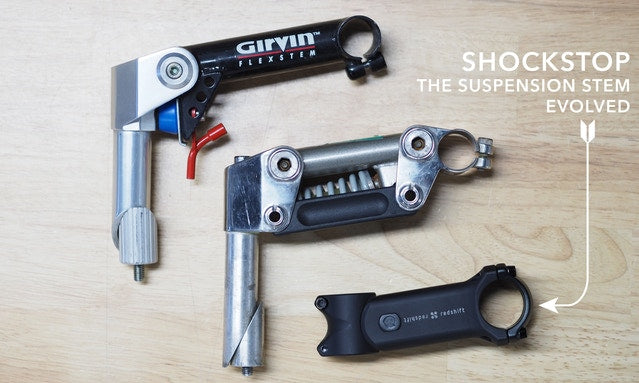What Makes the ShockStop Different?
One of the most common questions people ask is, "What makes the ShockStop different?" We wanted to provide some insight into some of the factors that we considered during the development of the ShockStop.
Some Background
We aren't the "inventors" of the suspension stem. Depending on who you ask, it was either Leonardo da Vinci or Albert Einstein who first uttered the words, "Man, this bike could really use a suspension stem."
In the late 80's and early 90's, just as mountain biking was exploding, a number of companies developed suspension stems for off-road riding. The most notable of these were the Softride Suspension Stem and the Girvin Flexstem. For a few years, riders on Softride stems even won multiple mountain bike world championships. But ultimately, mountain bike suspension stems were supplanted by suspension forks.

But if suspension stems were so awesome for mountain biking, why did they go extinct?
Well, it turns out they actually weren't that great for mountain biking, and they were hampered by the manufacturing and technology limitations of the era. Specifically:
- They were ugly. "Beauty is in the eye of the beholder." Okay, but I'll just come out and say it - the suspension stems of the past were just plain ugly. We can attribute this partly to the horrible color combinations that were so pervasive in the 80's and 90's (seriously, who thought bright yellow paint was a good idea?), but mostly, it's because the designs were big, clunky, and stuck out like a sore thumb.
- They messed with your bike's geometry. When you're riding over boulders and hopping over logs, you need a lot of suspension travel to cushion big impacts. The suspension stems of the past had up to 3-inches (75mm) of vertical travel, which meant that the effective geometry of your bike changed radically as the stem compressed. For a lot of people, it felt like they were falling over the handlebar every time they hopped over an obstacle.
- They were unreliable. The suspension stems of the 80's and 90's were some of the very first suspension pivots that were every built on bicycles, and it showed. The joints were prone to developing play, which made steering unreliable - pretty much the last thing you want when you're barreling down an off-road trail.
- They were heavy. This was partly due to the limitations of manufacturing techniques at the time, which relied on heavy welded construction, and partly because the stems required such a large travel range. Even though they were lighter than suspension forks, they were still 2-4 times heavier than a comparable rigid stem.
- All flex is not created equal. A suspension stem should be vertically compliant, but it also needs to be torsionally and laterally rigid to make sure that your bike's steering and handling are unaffected. Again, due to the limitations of the technology at the time, those early stems were pretty flexy all around, which meant your steering input might end up being more like a steering "suggestion".
- Large travel + no damping = Crazy rebound! When you compress a suspension stem down three inches, it has a tendency to spring back up just as fast. Needless to say, having your stem try to buck you off your mountain bike every time you land a jump is not ideal.
Well, that all sounds pretty awful. What makes the ShockStop different?
In a nutshell, we designed Shockstop specifically for riding on roads/trails (paved or unpaved), and we took advantage of the last 30 years of technological and manufacturing innovations to design a suspension stem the perfectly matches modern bikes.
- Limited suspension travel. The key difference between the ShockStop and past suspension stems is the range of suspension travel. Because the Shockstop is designed for road riding, the amount of required suspension travel is much, much smaller (1-2cm, since you're hopefully not encountering a lot of boulders or jumps during your road rides). Building the stem around this specific road travel range let us transform the entire design.
- Beautiful, Clean, Understated. Bikes are beautiful, and we didn't want the ShockStop to change that. The limited suspension travel allowed us to completely internalize the suspension elements and blend the design seamlessly with the appearance of modern bicycles. The subtle pivot design means you don't notice it unless you're looking for it.
- Modern design. 20 years of evolution in the full-suspension mountain bike industry means that pivot design and technology has improved drastically since the first stems were introduced. The ShockStop utilizes modern best-practices for suspension pivot design, including the same fully-sealed cartridge bearings that are used in high-end full-suspension mountain bikes. No slop, no play, no maintenance.
- Advanced manufacturing. We worked with our manufacturing partners to take advantage of the latest manufacturing techniques like 3D-forging, a process that uses an internal mandrel to shape the hollow part. This eliminates the need for welded joints and results in seamless parts that are incredibly strong and rigid.
- Lightweight - The ShockStop weighs a mere 238g. To put that in perspective, that's about 1/8th of a bottle of water more than a standard rigid stem.
- Adjustable - The ShockStop features dual interchangeable elastomer springs that let you fine-tune the suspension feel to perfectly match your riding style. You can mix and match the different elastomer stiffnesses to dial in the ride feel with much better resolution than the suspension stems of yore.
